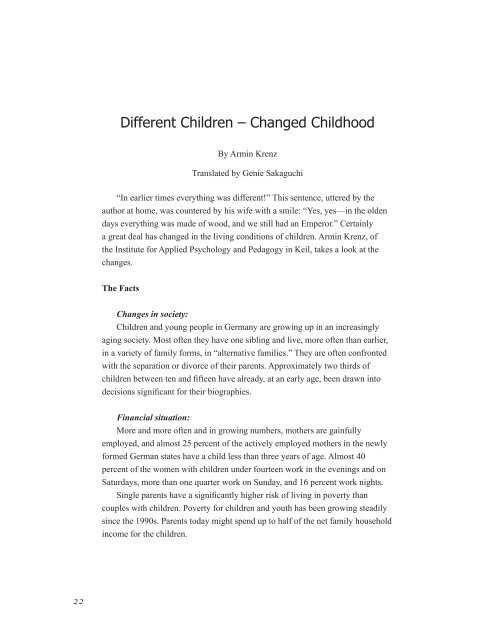Observing the Class Observing the Children - Research Institute for ...
Observing the Class Observing the Children - Research Institute for ...
Observing the Class Observing the Children - Research Institute for ...
You also want an ePaper? Increase the reach of your titles
YUMPU automatically turns print PDFs into web optimized ePapers that Google loves.
22<br />
Different <strong>Children</strong> – Changed Childhood<br />
By Armin Krenz<br />
Translated by Genie Sakaguchi<br />
“In earlier times everything was different!” This sentence, uttered by <strong>the</strong><br />
author at home, was countered by his wife with a smile: “Yes, yes—in <strong>the</strong> olden<br />
days everything was made of wood, and we still had an Emperor.” Certainly<br />
a great deal has changed in <strong>the</strong> living conditions of children. Armin Krenz, of<br />
<strong>the</strong> <strong>Institute</strong> <strong>for</strong> Applied Psychology and Pedagogy in Keil, takes a look at <strong>the</strong><br />
changes.<br />
The Facts<br />
Changes in society:<br />
<strong>Children</strong> and young people in Germany are growing up in an increasingly<br />
aging society. Most often <strong>the</strong>y have one sibling and live, more often than earlier,<br />
in a variety of family <strong>for</strong>ms, in “alternative families.” They are often confronted<br />
with <strong>the</strong> separation or divorce of <strong>the</strong>ir parents. Approximately two thirds of<br />
children between ten and fifteen have already, at an early age, been drawn into<br />
decisions significant <strong>for</strong> <strong>the</strong>ir biographies.<br />
Financial situation:<br />
More and more often and in growing numbers, mo<strong>the</strong>rs are gainfully<br />
employed, and almost 25 percent of <strong>the</strong> actively employed mo<strong>the</strong>rs in <strong>the</strong> newly<br />
<strong>for</strong>med German states have a child less than three years of age. Almost 40<br />
percent of <strong>the</strong> women with children under fourteen work in <strong>the</strong> evenings and on<br />
Saturdays, more than one quarter work on Sunday, and 16 percent work nights.<br />
Single parents have a significantly higher risk of living in poverty than<br />
couples with children. Poverty <strong>for</strong> children and youth has been growing steadily<br />
since <strong>the</strong> 1990s. Parents today might spend up to half of <strong>the</strong> net family household<br />
income <strong>for</strong> <strong>the</strong> children.

















